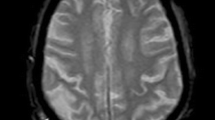Abstract
The significance of age as a prognostic factor was evaluated in patients undergoing carotid artery surgery between 12.8.86 and 31.10.92 in the Department of Vascular Surgery, Erlangen. 594 operations were performed on 546 consecutive patients using somatosensory evoked potentials as routine monitoring. Patients were divided into an older group of 139 (150 operations) with a mean age of 78.2 years and a younger group of 407 (444 operations) with a mean age of 64.4 years. There was no statistical difference in preoperative neurological status and number of risk factors, although there were different distributions of risk factors and concurrent illnesses. Thirty-day mortality rates were 1.7% for younger and 0.7% for older patients, and the incidence of postoperative stroke was 1.7% and 0.7% respectively (not statistically significant). Cumulative 5-year survival was 72.2% and 68.2% respectively. Cardiac diseases were the main cause of death in both groups, mainly fatal cardiac ischemia in younger patients and non-ischemic disease in the older patients. The 5-year stroke-free survival rate was 81 % and 91.3 % respectively (not significant). There was a trend towards a worse outcome for older patients with stages IIb and IV disease.
Zusammenfassung
Die Bedeutung des Alters als prognostischer Faktor im Rahmen der Karotischirurgie wurde anhand der vom 12.08.1986 bis 31.10.1991 an der Chirurgischen Universitätsklinik Erlangen durchgeführten primären Karotisrekonstruktionen untersucht. In diesem Zeitraum wurden 594 Operationen an 546 Patienten unter Ableitung von somatosensibel evozierten Potentialen (SEP) vorgenommen. Die Gruppe der über 75jährigen bestand aus 139 Patienten (150 Operationen), deren Durchschnittsalter bei 78,2 Jahren lag. Demgegenüber betrug das Durchschnittsalter der jüngeren Patienten 64,4 Jahre. Bezüglich der präoperativen neurologischen Stadienverteilung zeigte sich kein Unterschied zwischen den Altersgruppen. Allerdings ließ sich eine andere Verteilung sowohl der Risikofaktoren als auch der Begleiterkrankungen nachweisen. Bezogen auf die ersten 30 postoperativen Tage betrug die Mortalitätsrate 1,7% bzw. 0,7% in der Gruppe der unter bzw. über 75jäahrigen. Die entsprechenden Apoplexraten lagen bei 1,7% bzw. 0,7%. Es zeigte sich kein signifikanter Unterschied zwischen beiden Altersgruppen. Der Nachbeobachtungszeitraum lag zwischen einem und 68 Monaten. Die kumulierten Fünfjahresüberlebensraten betrugen 72,2% bzw. 68,2%. Kardiale Todesfälle standen unabhängig vom Alter an erster Stelle; bei den Jüngeren in erster Linie tödlich verlaufende Herzinfarkte, bei den Älteren andere kardiale Ursachen. Die kumulierten Fünfjahresapoplexfreiheitsraten lauten 81,0% bzw. 91,3%. Es war ein tendenziell schlechteres Abschneiden der älteren Patienten in den Stadien IIb und IV festzustellen.
Similar content being viewed by others
Literatur
Poeck K (1992) Neurologie. Springer, Berlin Heidelberg New York Tokyo
Wolf PA (1990) An overview of the epidemiology of stroke. Stroke [Suppl II] 21:II-4-II-6
Schweiger H, Kamp H-D, Dinkel M (1991) Somatosensory-evoked potentials during carotid artery surgery: Experience in 400 operations. Surgery 109/5:602–609
Schweiger H, Kamp H-D, Dinkel M, Jacob M, Lucke S (1990) Intraoperatives Monitoring in der Carotis- und Vertebralischirurgie. Angio Arch 19:39–42
Peto R, Pike MC, Armitage P, Breslow NE, Cox DR, Howard SV et al. (1976) Design and analysis of randomized clinical trials requiring prolonged observation of each patient (I). Br J Cancer 34:585–612
Peto R, Armitage P, Breslow NE, Cox DR, Howard SV, Mantel N et al. (1977) Design and analysis of randomized clinical trials requiring prolonged observation of each patient (II). Br J Cancer 35:1–39
Lee ET (1992) Statistical methods for survival data analysis. Wiley & Sons, New York
Beebe H (1989) Assessing risk associated with carotid endarterectomy. Circulation 79:472–473
Benhamou AC, Kieffer E, Tricot JF et al. (1981) Carotid artery surgery in patients over 70 years of age. Int Surg 66:199–202
Brott T, Thalinger K (1985) The practice of carotid endarterectomy in a large metropolitan area. Stroke 15/6:950–955
Courbier R, Ferdani M, Reggi M (1985) Carotid stenosis. Surgery after 75 years. Int Angio 4:295–299
Plecha FR, Bertin VJ, Plech EJ, Avellone JC, Farrell CJ et al. (1985) The early results of vascular surgery in patients 75 years of age and older: An analysis of 3259 cases. J Vase Surg 2:769–774
Ouriel K, Penn TE, Ricotta JJ, May AG, Green RM, DeWeese JA (1986) Carotid endarterectomy in the elderly patient. Surg Gyn Obst 162:334–336
Rosenthal D, Rudderman RH, Jones DH et al. (1990) Carotid endarterectomy in the octogenarian: Is it appropriate? J Vasc Surg 11/5:782–787
Loftus CM, Biller J, Godersky JC, Adams HP, Yamada T, Edwards PS (1988) Carotid endarterectomy in symptomatic elderly patients. Neurosurgery 22:676–680
Pinkerton JA jr, Gholkar VR (1990) Should patient age be a consideration in carotid endarterectomy? J Vasc Surg 11:650–658
Schröe H, Suy R, Nevelsteen A (1990) Carotid artery endarterectomy in patients over seventy years-of-age. Ann Vasc Surg 4:133–137
Meyer FB, Meissner I, Fode NC, Losasso TJ (1991) Carotid endarterectomy in elderly patients. Mayo Clin Proc 66:464–469
Brook RH, Park RE, Chassin MR et al. (1990) Carotid endarterectomy for elderly patients: Predicting complications. Ann Intern Med 113:747–753
Fisher ES, Malenka DJ, Solomon NA, Bubolz TA, Whaley FS, Wennberg JE (1989) Risk of carotid endarterectomy in the elderly. Am J Public Health 79:1617–1620
Gibbs B et al. (1989) Carotid endarterectomy in community practice: surgeon-specific versus institutional results. Ann Vasc Surg 3:307–312
Author information
Authors and Affiliations
Rights and permissions
About this article
Cite this article
Hoffmann, A., Schweiger, H. Die Karotisendarteriektomie beim älteren Patienten. Langenbecks Arch Chir 378, 297–303 (1993). https://doi.org/10.1007/BF00183968
Received:
Issue Date:
DOI: https://doi.org/10.1007/BF00183968




